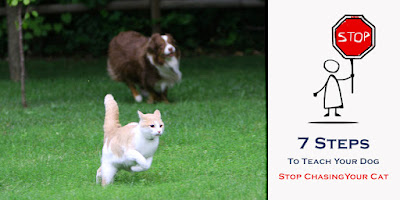Wooohoooo...purrrrrrrrrrr…..wooohooo……..puurrrrrrrrrrrr….is
that dog and cat wild chase going round in your house, and you’re frustrated
and irritated by this situation. With both the pets in the household, many pet
parents may face this stressful environment. Dogs and cats cannot be fabulously
good friends and that chase game always exist between them.
To
help them co-exist peacefully under one roof, pet parents have to clearly put
into their mountainous efforts to handle their pets in order to stop that mad
chase. Get onto your heels and run into these 7 effective steps to teach your
dog to stop chasing your kitty.
Keep The Cats Out Of Reach
Dogs
like to chase cats – may be due to the act of jealously or the age old enmity
that must have followed the legacy. With both kinds of pets in your adobe, it
becomes crucial to keep them separate in order to have a hold on this act of
your dog. Provide separate space for both your cat and a dog. Always keep your
cats out of reach of your dog. When your dogs are mostly outdoors, let your cat
be indoors and vice versa.
Keep Watch On Cats Before Dogs
Are Out
The
easiest way is to keep a watch on your cat. Whether she is roaming in the yard
or yawning under that chair. Ensure that your dog is away. Your dog can’t chase
and catch the cats that aren’t in the vicinity. Make it a habit that if you’re
letting your dog out in the open check where your cat is.
Teach Good Cat Lessons To Your
Dog
To
have harmonious environment in the house with both the animals existing, it
becomes paramount to teach them good
friendship lessons. Dogs are easier to train and being friendly by nature can
quickly learn the message you want to pass. Take your dog on leash and
introduce him to your cat. When barking at the cat, hold him tightly with the
leash and when he stops reward him with a treat. Repeat this training session
couple of times for a few days and your dog will start behaving in the coat in
spite of your cat roaming around.
Induce Physical And Mental
Exercise In Your Dog
Dogs
tend to chase cats in the way to kill their boredom or just for fun as they are
full of energy. Introduce your dog to some physical exercise like ball throw
game, chasing a throw stick or giving him a chew toy. This will exhaust him for
the day with no room left to have that Tom and Jerry chase game going around
the house.
Training Dogs To Follow Your
Command
Dogs are good at listening to commands under
good trainers. Your dog well-trained with “sit”, “stand” command can easily
follow your “leave it” command. With the leash on your dog, let him chase the
cat. With the hand sign, command him to leave it. When he is stops, reward your
dog with a treat. Repeat this training several times, and eventually he follows
the ‘LEAVE IT’ command.
Help Your Cat Too
Cats
are no less than dogs. Some of those purrs try to irritate the dogs and the
outcome; you can just see that wild chase marathon in your house or the yard.
Help your cat to change her association with your dog by feeding her tasty
chews, while she is in the dog’s presence. Similarly, provide treat to your dog
for his calm composure. You can even revamp the environment with cat safety
zone – that is inaccessible to your dog. Provide lot of high perches for your
cat or set up baby gates to create safe zones.
If you
still find that you are not able to cope up with this situation or going mad
with that dog chasing cat scenario, then take a help of a professional. A dog
trainer can surely bring in some good news for you.



